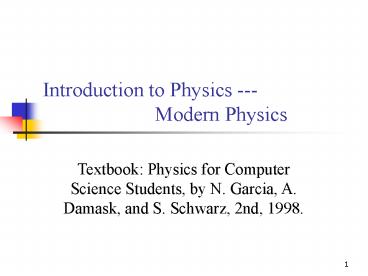Introduction to Physics --- Modern Physics - PowerPoint PPT Presentation
Title:
Introduction to Physics --- Modern Physics
Description:
Introduction to Physics ---Modern Physics Textbook: Physics for Computer Science Students, by N. Garcia, A. Damask, and S. Schwarz, 2nd, 1998. Chapter Thirteen ... – PowerPoint PPT presentation
Number of Views:483
Avg rating:3.0/5.0
Title: Introduction to Physics --- Modern Physics
1
Introduction to Physics ---
Modern Physics
- Textbook Physics for Computer Science Students,
by N. Garcia, A. Damask, and S. Schwarz, 2nd,
1998.
2
Chapter Thirteen Electrostatics
- The interaction of charges at rest is called
electrostatics. - Superposition principle The behavior of multiple
charges on one another is a simple sum of the
one-to-one interactions (pairwise).
3
Charges
- There are two different types of charges called
positive and negative. - Metals have been known as electrical conductors
and nonmetals as insulators.
4
Coulomb's Law
- Attraction and repulsion of charges see Fig.
13-2. - Coulomb's experiments concerning the forces
between charges see Fig. 13-3. The force diagram
for q2 is shown in Fig. 13-3b and the system is
in the equilibrium state. Thus,
5
6
7
- Coulomb's law
- where the sign of q1 and q2 may be either plus
or minus, and r is the distance between q1 and
q2. - In the SI system the constant in Coulomb's law is
taken as
8
- The symbol C stands for Coulomb and is the unit
of charge. - The charge of the electron in coulombs is
- Coulomb's law
- The direction of the force that q1 exerts on q2
is along the line joining the two charges,
pointing away from q1 if the force is repulsive
or toward q1 if the force is attractive.
9
Example 13-1
- Two pith balls of mass 0.1g each are suspended on
50-cm threads. They are given equal charges and
assume a position in which each makes an angle of
with vertical, as in Fig. 13-4a. What is
the charge on each?
10
11
Sol
- The vector diagram of the forces on the
right-hand ball is shown in Fig. 13-4b, where F
is the coulombic force of repulsion between the
two charged pith balls.
12
- Substituting this value of T in the equation for
F, we have
13
- Using Coulomb's law,
- Because q1 q2 and substituting for F and r we
have
14
Charge of an Electron
- In the years 1909 through 1913 R. Millikan
measured the charge on an electron by the system
shown in Fig. 13-5. - With a spray he introduced fine oil drops between
two parallel metal plates and observed the motion
of a single drop through a telescope. - He found the drops usually acquired a negative
charge.
15
16
- He also found that the smallest charge that was
ever acquired by the drop had a magnitude of
C and that larger charges were
always integral multiples of this quantity.
17
Superposition Principle
- If one selects a given charge in a group and asks
for the total force on it, this force would be
the resultant of the individual vector forces on
it from each of the charges. This is called the
superposition principle of charges.
18
Example 13-2
- Three charges are arranged in a triangle as shown
in Fig. 13-6a. What is the direction and the
magnitude of the resultant force on the
C charge?
19
20
Sol
- at above the positive x axis.
- at below the positive x axis.
21
- We now use the vector diagram of these two forces
and find the resultant by the component method of
Chapter 2. We have
22
Homework
- 13.4, 13.9, 13.10, 13.11, 13.12, 13.13, 13.14.

















![L 34 Modern Physics [1] PowerPoint PPT Presentation](https://s3.amazonaws.com/images.powershow.com/7125701.th0.jpg?_=20150905079)
![L 35 Modern Physics [1] PowerPoint PPT Presentation](https://s3.amazonaws.com/images.powershow.com/7552279.th0.jpg?_=20160119094)

![L 33 Modern Physics [1] PowerPoint PPT Presentation](https://s3.amazonaws.com/images.powershow.com/7602675.th0.jpg?_=201602121011)








![Download Book [PDF] Hawley, J: Foundations of Modern Cosmology PowerPoint PPT Presentation](https://s3.amazonaws.com/images.powershow.com/10050367.th0.jpg?_=20240607117)

